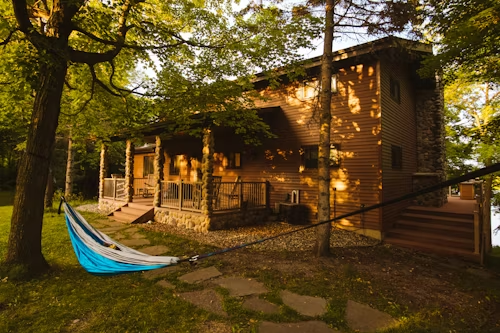Modern log homes are increasingly becoming a popular choice for homeowners who seek a blend of rustic charm and contemporary living.
With growing awareness about environmental sustainability, many people are now exploring ways to make these homes more eco-friendly. Incorporating green technologies and sustainable materials can significantly reduce the environmental impact of log homes.
This article will explore various eco-friendly upgrades for modern log homes in the year 2024, helping you create a sustainable and comfortable living space.
Energy-Efficient Insulation
Proper insulation is crucial for maintaining a comfortable temperature in log homes throughout the year. Advanced insulation materials and techniques can significantly reduce energy consumption, leading to lower utility bills and a smaller carbon footprint.
One popular choice is using cellulose insulation, which is made from recycled paper products. This material is not only effective at insulating but also environmentally friendly. Additionally, consider using rigid foam insulation boards, which provide excellent thermal resistance and are often made from recyclable materials. For those interested in log homes in Ontario, implementing high-quality insulation can be a game-changer, particularly in the region’s varied climate.
It’s worth noting that well-insulated log homes in Ontario can better withstand both cold winters and hot summers, ensuring year-round comfort and energy savings.
Solar Power Integration
Harnessing solar energy is one of the most effective ways to make a log home more eco-friendly. Installing solar panels on the roof can significantly reduce reliance on non-renewable energy sources. Advances in solar technology have made it more accessible and affordable than ever before.
Besides traditional solar panels, consider integrating solar shingles, which blend seamlessly with the roof design while providing the same energy benefits. Solar energy can be used to power various household appliances and systems, reducing the overall carbon footprint of the home.
Additionally, solar water heaters can provide an eco-friendly alternative for heating water, further enhancing the home’s sustainability.
Sustainable Building Materials
- Reclaimed Wood: Using reclaimed wood for construction and interior design not only adds character to the log home but also reduces the demand for new timber. This practice helps conserve forests and minimises waste.
- Bamboo: Known for its rapid growth and renewability, bamboo is an excellent alternative to traditional wood. It’s durable and versatile, making it suitable for flooring, cabinetry, and furniture.
- Recycled Metal: Incorporating recycled metal for roofing, fixtures, and accents can add a modern touch to log homes while being environmentally responsible. Metals like aluminium and steel are often recycled and reused, reducing the need for new mining.
- Eco-Friendly Paints and Finishes: Opt for paints and finishes that are low in volatile organic compounds (VOCs). These products release fewer harmful chemicals into the environment and contribute to better indoor air quality.
Clay plaster is another sustainable material that can be used for interior walls. It is natural, breathable, and helps regulate indoor humidity levels.
Additionally, straw bale construction is gaining popularity for its excellent insulation properties and sustainability. Straw bales are stacked to form walls, then coated with plaster to create a durable and energy-efficient structure. By selecting sustainable building materials, homeowners can create a log home that is both beautiful and environmentally friendly.
Water Conservation Systems
Water conservation is another critical aspect of creating an eco-friendly log home. Implementing rainwater harvesting systems can significantly reduce the reliance on municipal water supplies. Collected rainwater can be used for irrigation, toilet flushing, and even laundry.
Additionally, installing low-flow fixtures and appliances can greatly reduce water consumption. Dual-flush toilets, low-flow showerheads, and water-efficient dishwashers are just a few examples of how you can save water. Greywater recycling systems, which reuse water from sinks, showers, and laundry for irrigation, can also be a valuable addition to a sustainable log home.
Efficient Heating And Cooling Systems
- Geothermal Heating and Cooling: Geothermal systems utilise the stable temperature of the earth to heat and cool the home efficiently. This technology can reduce energy consumption by up to 70% compared to traditional systems.
- Radiant Floor Heating: This system uses heated water running through pipes beneath the floor to provide consistent and comfortable warmth. It’s more efficient than forced-air systems and can be powered by renewable energy sources.
- Energy-Efficient Windows: Installing double or triple-glazed windows can significantly reduce heat loss in the winter and keep the home cooler in the summer. Look for windows with low-emissivity (low-E) coatings to enhance energy efficiency.
- Programmable Thermostats: These devices allow homeowners to set and adjust temperatures based on their schedules, reducing energy waste and saving on utility bills.
Air source heat pumps are another efficient option, transferring heat between the indoor and outdoor air to provide heating and cooling. These systems can be highly energy-efficient and are suitable for various climates. Ceiling fans and attic ventilation systems can also help maintain a comfortable indoor temperature while reducing the load on heating and cooling systems. By integrating these efficient heating and cooling solutions, homeowners can create a comfortable living environment while minimising energy consumption.
Conclusion
Making eco-friendly upgrades to modern log homes not only benefits the environment but also enhances the quality of living. With the right strategies and technologies, log homes can offer a perfect blend of rustic charm and modern sustainability, setting a standard for environmentally conscious living in 2024 and beyond.












